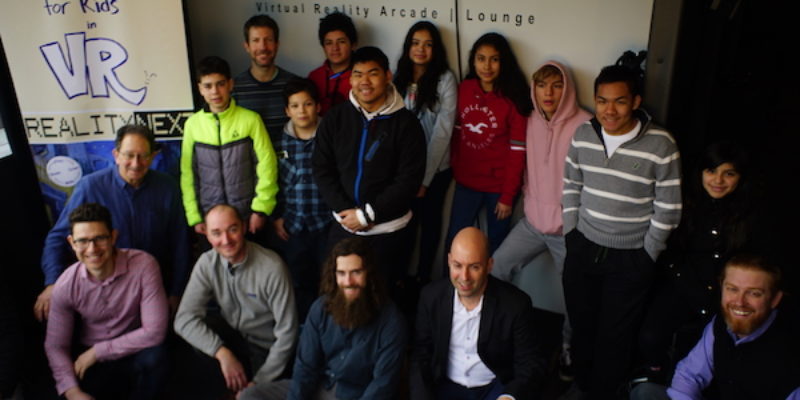When 13 teens showed up at Fluke Hall on the University of Washington campus one wet November day, they had no idea what they were in for. When they emerged from Portal VR in Ballard on Jan. 28, they had just played a virtual reality game they had made through learning, narrative-building, performance and collaboration.
“I liked it. It was very different from what I would have expected it to be,” said Vichette Ros, a 9th grader from Choice Academy in Burien.

Ros didn’t know what to expect because the workshops in this game-creation process had never been done before—they were the first in a series led by Seattle-based startup RealityNext. Over the course of two day-long sessions in November and December, RealityNext co-founders Alex Stolyarik and Joel Magalnick worked with the students and a volunteer crew that included Art Feinglass, director of the Seattle Jewish Theater Company, Luke Tokheim, co-founder of Shadow Motion Workshop, and software developer Michael Gelon to create a story and game based on photosynthesis and the carbon cycle.
“The interesting thing for me was the imagination of kids—could they convert subjects into stories and games?” Stolyarik said. “They can totally do it, and create fantastic and interesting narratives about science, something that is not easily played in a game setting.”
Stolyarik and Magalnick have been working on the RealityNext concept since last June, when they set up shop at the University of Washington’s CoMotion Labs. Stolyarik, 43, worked in the finance sector as CEO of a Moscow-based institution in the late 2000s and later founded a land-development education program that he said serves as the original model of the RealityNext program. Magalnick, 46, spent 12 years as editor-in-chief of a community media company, which he says is perfect for implementing the storytelling aspects of the RealityNext concept.

As Stolyarik and Magalnick began working together, both saw an opportunity to “change the way kids can interact with each other by teaching peer to peer,” Magalnick said, “but at the same time putting them into a safe environment that encourages teamwork.”
The release of RealityNext’s first game comes at a time when adoption of virtual reality is on the rise. Given the high costs of entry, however—a headset and computer powerful enough to handle the intense graphics and data load of a VR experience runs $1,500 to $2,000—home-based adoption has not been as robust as industry leaders have hoped, according to Venture Beat. The entertainment magazine Variety reported in July that film companies, IMAX in particular, have begun investing in VR arcades to supplement their theatrical releases.
RealityNext’s goal, according to Stolyarik, is to open locations where teen can come, whether for afterschool programs, summer camps, or as school groups, to create their stories and games in what he called a “Maker Lab” over the course of two or three sessions. The other goal, he said, “is to put the workshops, which these kids did in an open space, entirely into VR so they can choose their characters, backgrounds and objects to manipulate while they make their stories.”

With the kids broken into three groups to act out their stories, Shadow Motion’s Tokheim affixed sensors to the arms, legs, head and midsection on half the group to digitally record each person’s movements, then had them switch places. He said he was impressed with how the students took to the acting process.
“That’s kind of an advanced thing to be able to pretend to act with somebody who’s wearing the motion capture suit and someone who’s not,” Tokheim said. “The kids adjusted to that naturally.”
Gelon, the software developer, collected the motion-capture recordings, the students’ storyboards, and samples of background images. He overlaid virtual skins onto the recorded performances—in raw form skeletons on a grid background—which, in the final release, became five related stories accessed from a space-age virtual classroom.
“I liked how you made it something I would not have expected it to be,” Vichette, the 9th-grade student, told Gelon. “I think you did really good with the surrounding environment it was in.”
“I tried to bridge that gap between ‘this is cool, this is new, this is realistic,’ but also, ‘this is a kid’s storytelling device,’” Gelon responded.
Vlad Postel, a project manager at Microsoft who attended the game launch event, said he enjoyed how the teens enjoyed the experience they created. “I love the fact the kids were really making something from zero to 100, and it was interesting to see how they built it,” Postel said. “The end result was pretty impressive.”




